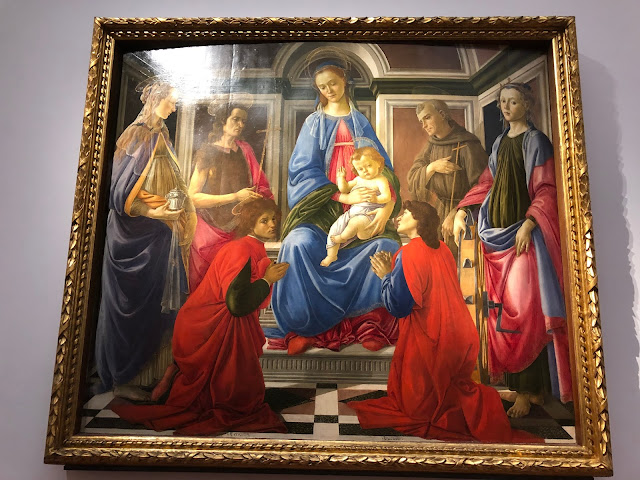【フィレンツェ】ウフィツィ美術館 ボッティチェリ Firenze - Gallarie degli Uffizi : Botticelli
ボッティチェリの作品といえば、『プリマヴェーラ』や『ヴィーナスの誕生』が有名だが、ウフィツィ美術館には他にも多くの作品が展示されていた。
ボッティチェリは、若い頃はフィリッポ・リッピの弟子をしていた。この作品には、リッピの影響が強く感じられる。
うつむいてやや憂いを帯びた聖母子の表情などは、リッピの描いた聖母子の表情とそっくりだ。
Speaking of Botticelli's works, "Primavera" and "The Birth of Venus" are famous, but many other works were exhibited at the Uffizi Gallery.
Botticelli was a disciple of Filippo Lippi when he was young. Lippi's influence is strongly felt in this work.
The expression of the Virgin and Child, who is depressed and slightly sad, is similar to the expression of the Virgin and Child drawn by Lippi.
その後、ヴェロッキオの工房にいたこともあったが、やがてボッティチェリは独立して自らの工房を立ち上げた。
特にメディチ家に気に入られて、教会などを中心に多くの作品を弟子たちと共に描いた。
この受胎告知の絵は、1489年に描かれた作品で、人物の表情はリッピやヴェロッキオの影響からは脱して、いわゆるボッティチェリの描く典型的な表現になっている。
After that, he was in Verrocchio's workshop, but eventually Botticelli set up his own workshop independently.
He was particularly fond of the Medici family and painted many of his works with his disciples, especially in churches.
This painting of the Annunciation was drawn in 1489, and the facial expression of the person is a typical expression drawn by so-called Botticelli, excluding the influence of Lippi and Verrocchio.
ボッティチェリは、トンドと呼ばれる円形の作品でも多くの傑作を残している。
このトンドはその代表作で、色合いも美しく、描かれている人々の表情や仕草も多彩だ。
ただし、肝心の幼児イエスの両目のバランスに、少し不自然さを感じてしまう。
Botticelli has also left many masterpieces in a circular work called Tondo.
This tond is his masterpiece, with beautiful colors and a variety of facial expressions and gestures of the people depicted.
However, the balance between the eyes of the important infant Jesus feels a little unnatural.
こちらのトンドも美しい。
中央の聖母の着ている洋服は、上のトンドとほとんど同じように見える。
この聖母の表情は、『ヴィーナスの誕生』のヴィーナスの表情と瓜二つだ。
This tond is also beautiful.
The clothes worn by Our Lady in the center look almost the same as the Tondo above.
The expression of this Virgin is the same as that of Venus in "The Birth of Venus".
1494年から1496年頃に描かれたと言われる、『アペレスの誹謗』。
古代ギリシャの有名な画家、アペレスが描いたと言われる絵画の再現を試みた作品。
レオン・バティスタ・アルベルティが『絵画論』において、学ぶべき歴史画としてこの絵をあげたことから、当時の多くの画家がその再現を試みた。
アペレスは、友人の画家がエジプト王プトレマイオス4世の前で誹謗を受けたことから、それに抗議して誹謗をテーマにした作品を描いて、王に送ったと伝えられている。
ボッティチェリは、サヴォナローラの思想に心酔し、そのサヴォナローラが処刑されてしまった後は、そのショックからか、制作する絵画の数は激減してしまったと言われている。
ヴァザーリによれば、生活にも困るようになってしまったボッティチェリを、かつてのパトロンだったメディチ家が支援して、ようやく餓死することから免れたという。
ボッティチェリは1510年にひっそりと亡くなった。
ルネサンスを代表する作品を残したこの偉大な画家の最後としては、とても寂しい最後であったと言えるかもしれない。
"Apelles slander", which is said to have been drawn from 1494 to 1496.
A work that attempts to reproduce a painting that is said to have been painted by the famous ancient Greek painter Apelles.
Leon Battista Alberti mentioned this painting as a historical painting to learn in "Painting Theory", and many painters at that time tried to reproduce it.
Apelles reportedly sent a slander-themed work to the king in protest of his friend's painter being slandered in front of King Ptolemy IV of Egypt.
It is said that Botticelli was fascinated by Savonarola's ideas, and after the execution of Savonarola, the number of paintings he produced decreased sharply, probably because of the shock.
According to Vasari, he was finally spared from starvation with the help of his former patron, the Medici, who had become troubled with his life.
Botticelli died quietly in 1510.
He may be said to have been a very lonely end for this great painter who left behind a work representing the Renaissance.
(Translated by Google Translate)







コメント
コメントを投稿